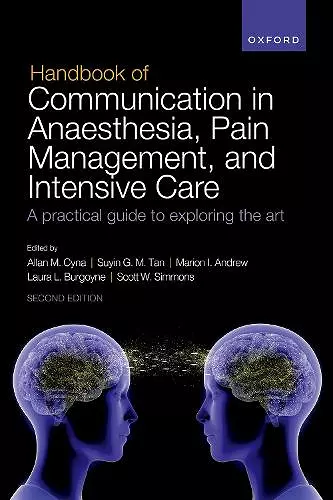Handbook of Communication in Anaesthesia, Pain Management, and Intensive Care
A practical guide to exploring the art
Allan M Cyna editor Marion I Andrew editor Suyin GM Tan editor Laura L Burgoyne editor Scott W Simmons editor
Format:Paperback
Publisher:Oxford University Press
Published:16th Sep '24
Should be back in stock very soon

Communication in anaesthesia, pain management, and intensive care can have profound impacts on patients and healthcare colleagues. Good communication can result in better patient outcomes and experiences of the hospital setting, whereas poor communication is frequently at the heart of adverse incidents, complaints, and litigation. This handbook outlines two model frameworks to improve communication: one to give structure to an interaction and one that explores language structures and the layers of meaning to our words. The frameworks are essential tools for communicating with children, obstetric patients, and those with needle phobia. A practical guide, the book is packed with useful tips to enhance interactions with both patients and colleagues. Numerous examples and vignettes clearly demonstrate ideas that will improve patient care, safety, and bring out the best in everyone around. Fully updated with new clinical guidelines and literature, the second edition includes new chapters on how to talk to patients in pain, featuring motivational interviewing techniques, and on social media. Increased coverage of managing challenging situations, includes communicating with distressed relatives, dealing with complaints, and working with interpreters. The contributors and editors are senior clinicians from North America, Europe, and Australasia, working at the coalface of perioperative and critical care. Blending theory, science, and practicality, this book complements resources for communication skills teaching in anaesthesia and other related professional groups.
Review from previous edition Overall, this is an excellent resource on effective communication in healthcare. It brings up interesting communication concerns with patients interacting with anesthesiologists in different clinical contexts and it reminds one to prioritize patient perceptions that will allow patient autonomy and cooperation and decrease patient anxiety. * Doody's Listings 01/05/2011 *
This is an excellent introductory book on communication for trainee or consultant anaesthetists aiming to fine tune their interactions and teaching prowess ...suprisingly refreshing from the outset...I thoroughly enjoyed this book and recommend it to specialist registrars and consultants in respiratory medicine - go out and get a copy for your department. * British Journal of Hospital Medicine 01/06/2011 *
I enjoyed reading this book, and I have gained lots of useful tips from doing so... the book has a lot to offer the interested reader and would make an excellent addition to any bookshelf or departmental library. * Anaesthesia 20/01/2012 *
This is an excellent introductory book on communication for trainee or consultant anaesthetists aiming to fine tune their interactions and teaching prowess. It certainly forms a solid platform for those interested in reading further into these areas. Books like this can very often appear too 'fluffy' to the palate, but this one is surprisingly refreshing from the outset. * British Journal of Hospital Medicine, June 2011 *
ISBN: 9780198858669
Dimensions: 235mm x 157mm x 13mm
Weight: 502g
360 pages
2nd Revised edition